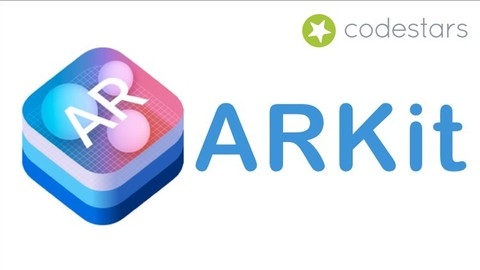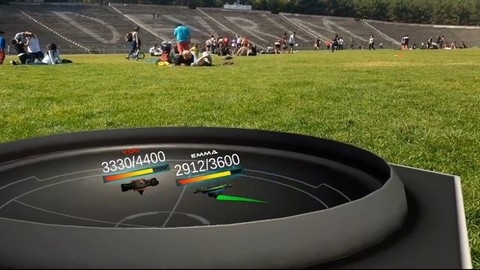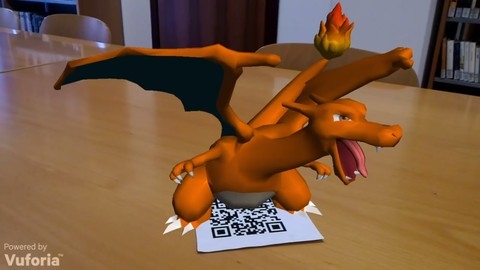Augmented Reality (AR) is a technology that overlays digital information onto the real world, creating interactive experiences that blend the virtual and physical.
This field is rapidly growing, offering exciting opportunities in gaming, education, healthcare, and more.
Learning AR development can open doors to innovative careers and allow you to create immersive and engaging experiences.
Finding a high-quality AR course on Udemy that meets your specific needs can be a daunting task.
With so many options available, you’re likely looking for a program that provides practical skills, hands-on projects, and expert guidance.
For the best augmented reality course overall on Udemy, we recommend Build 15 Augmented Reality (AR) apps with Unity & Vuforia.
This comprehensive course dives deep into AR development using Unity and Vuforia, the industry-leading tools for creating AR experiences.
It includes 15 real-world projects, covering a wide range of AR techniques, from basic image tracking to advanced object recognition and virtual button interaction.
This is just the beginning of our journey into the world of AR on Udemy.
We have a variety of courses for different skill levels and interests.
Keep reading to explore our recommendations for beginner-friendly introductions, advanced courses focused on specific AR frameworks, and even courses tailored to specific industries like gaming and healthcare.
Build 15 Augmented Reality (AR) apps with Unity & Vuforia
The course starts by explaining the fundamentals of augmented reality and how it differs from virtual reality.
You’ll learn to install Unity, navigate its interface, and work with game objects, physics, lighting, and materials.
These basics lay the groundwork for diving into AR development.
Once you’ve grasped the Unity essentials, the course dives into the Vuforia plugin, which enables AR capabilities within Unity.
You’ll learn to import Vuforia, create image targets, and project 3D models onto those targets, like placing a 3D barbarian model on an image.
This hands-on approach continues as you build an augmented reality book app, where you’ll sketch images and overlay 3D objects on top.
The course covers advanced AR techniques like simultaneous image tracking using a greeting card, creating virtual buttons to interact with AR objects, and markerless AR for placing objects on surfaces or in mid-air.
You’ll also explore object tracking by scanning real-world toys and superimposing digital 3D models.
Other notable projects include cylindrical object tracking with animated 3D planes and clouds, video playback in AR, cloud recognition to fetch information based on image targets, and user-defined targets that project 3D models on any image.
The course even touches on VuMark, Vuforia’s unique image recognition system.
Throughout the syllabus, you’ll work on building complete AR apps for Android and iOS, learning to customize UI elements, add animations and visual effects like depth mask shaders for “window portal” AR experiences.
The variety of projects ensures you gain practical experience with diverse AR development techniques.
The Complete ARKit Course - Build 11 Augmented Reality Apps
This syllabus offers a comprehensive introduction to Augmented Reality (AR) development using Apple’s ARKit framework.
You’ll embark on a journey from basic AR concepts and Xcode setup to more complex projects, building everything from simple 3D objects to virtual cars and portals.
The syllabus is structured logically, starting with foundational ARKit principles and gradually progressing to advanced topics like physics simulations and distance measurements.
You’ll appreciate the inclusion of optional lessons on Xcode and Swift, making the course accessible to beginners.
One notable aspect of this syllabus is its emphasis on practical learning.
You’ll gain hands-on experience through numerous projects, applying your knowledge and exploring ARKit’s capabilities.
The inclusion of downloadable resources and helpful links will further enhance your learning experience.
This syllabus covers a wide range of AR development topics, equipping you with the skills to create engaging and visually stunning AR experiences.
Whether you’re a novice developer or looking to deepen your AR knowledge, this syllabus provides a solid foundation for your journey into the world of augmented reality.
Augmented Reality in Depth 101
This course provides a solid foundation for anyone interested in diving into the world of Augmented Reality (AR).
You’ll start by understanding the core concepts, exploring the differences between AR and Virtual Reality (VR), and learning about various display technologies and the Reality Virtuality Continuum.
This strong theoretical foundation sets the stage for practical application.
The course then transitions to hands-on experience using Unity3D and Vuforia.
You’ll learn to set up your development environment and build your first AR project.
As you progress, you’ll create increasingly complex projects, such as an interactive globe app that lets users explore a virtual world.
You’ll learn scripting, which will allow you to add functionality to your AR experiences and build apps for both Android and iOS platforms.
The course goes beyond basic principles, delving into advanced topics like Super-Imposition, where you’ll learn to blend real and virtual objects in your AR experiences.
You’ll also gain experience working with .odt files in Unity to create interactive AR scenes and learn to build apps with animated models.
Throughout the course, you’ll utilize tools like PhotoScape for image editing and Mixamo for character animation.
Furthermore, the course offers bonus lectures on Ethical Hacking and Web Application Penetration Testing using C|WAPT.
This unique addition allows you to explore the intersection of AR and cybersecurity, expanding your knowledge beyond the typical AR curriculum.
Build A Multiplayer Augmented Reality (AR) Game With Unity
This course dives headfirst into the world of AR game development, equipping you with the skills to build immersive, multiplayer experiences.
You’ll start by mastering the fundamentals of Unity, the industry-standard game engine, and then delve into the power of Photon for creating seamless multiplayer interactions.
The course takes a practical approach, guiding you through the creation of an AR game from scratch.
You’ll learn to implement player movement, synchronize physics across the network, and tackle the unique challenges of building a game that blends the virtual and real worlds.
You’ll explore advanced techniques like lag compensation to ensure a smooth gameplay experience for all players, regardless of their network connection.
The course’s focus on AR development is particularly noteworthy.
You’ll learn how to detect planes, place objects in the real world, and manage the complexities of multiplayer AR synchronization.
You’ll even discover strategies for optimizing your game for mobile devices, ensuring it runs flawlessly on both Android and iOS.
While the course offers a comprehensive exploration of AR game development, it’s important to note that it assumes a basic understanding of programming concepts.
For those completely new to game development, some prior knowledge or additional resources might be helpful.
If you’re ready to take your game development skills to the next level and build engaging AR experiences, this course is an excellent starting point.
Build an Augmented Reality android app in 1 hour!
This course is a great introduction to the world of augmented reality (AR) app development for Android.
It’s designed to be fast-paced and hands-on, guiding you through the creation of a complete AR app within an hour.
You’ll begin by exploring the fundamentals of AR, diving right into two essential tools: Vuforia and Unity3d.
Vuforia, a popular AR SDK, will become your companion in creating interactive AR experiences using your smartphone camera.
You’ll learn how to use Vuforia to create “marker/image targets,” the foundation for bringing virtual objects into the real world through your phone’s camera.
Next, you’ll encounter Unity3d, a powerful software used to develop 3D games and applications.
The course provides a solid introduction to Unity3d, covering essential concepts like “prefabs” – ready-made 3D objects you can integrate into your AR app.
You’ll also be introduced to the Unity Asset Store, a treasure trove of resources to enhance your AR creations.
The culmination of this course is the exciting process of bringing all the pieces together to build a functional AR app.
You’ll learn how to seamlessly integrate Vuforia with Unity3d, add a “Red Samurai” 3D model to your scene, and test your app on both Windows and Android platforms.
Intro to Augmented Reality on the Web: WebXR and Three.js
You’ll start with hands-on projects, building AR experiences on both iOS and Android devices, as well as on your computer, ensuring a versatile learning experience.
You’ll quickly move into exploring the WebXR API, the foundation of these experiences.
The course delves into the benefits of web-based AR, highlighting its potential for easy sharing and collaborative development.
Building on this foundation, you’ll dive into Three.js, a powerful library for creating 3D graphics on the web.
Through guided exercises, you’ll set up your development environment and build your first AR app from scratch.
The course covers the fundamentals of Three.js, leading you through creating simple shapes, adding animations, and integrating complex 3D models.
You’ll learn how to leverage WebXR to transform these creations into interactive AR experiences.
The true power of AR comes to life with user interaction.
You’ll learn how to implement touch gestures, making your AR experiences more immersive.
The course provides a detailed explanation of hit testing, a crucial technique for detecting real-world surfaces and enabling AR objects to interact with their environment.
Create Your Own Augmented Reality Application
This course is a great introduction to the world of augmented reality (AR) and the potential of the Merge Cube as a tool for creating your own interactive experiences.
You’ll start by diving into the fundamentals of AR, exploring its different types and how it works.
Then, you’ll learn about the Merge Cube, a unique and affordable device that allows you to bring your digital creations to life.
The course guides you through the process of creating your own Merge Cube, from printing it to using it with your phone.
But the real fun begins when you learn to build 3D shapes using Tinkercad, a user-friendly design program.
You’ll then import these shapes into CoSpaces, a platform that lets you craft interactive environments for your Merge Cube.
Imagine creating your own virtual spaces, adding objects, and even animating them – all to be experienced with your very own Merge Cube.
You’ll also discover additional AR resources, like the Metaverse and apps like Dig and Object Viewer, which enhance the Merge Cube’s capabilities.
You’ll learn how to use apps like You Augment to create your own AR experiences, expanding your knowledge beyond the Merge Cube itself.
This course provides a solid foundation in AR and empowers you to start creating your own interactive experiences.
Whether you’re interested in exploring AR for fun or as a stepping stone to a career in this rapidly growing field, this course is a great place to start your journey.
Augmented Reality Portal using Apple ARKit framework for AR
If you’re looking to break into the world of augmented reality development, this course offers a practical introduction to Apple’s ARKit framework.
You’ll learn how to build a captivating AR portal, gaining hands-on experience with key concepts like horizontal plane detection and virtual object placement.
The course walks you through the process of preparing 3D assets using Blender, a widely used 3D modeling software, and integrating them into your AR experience.
You’ll learn how to create a visually appealing portal, complete with realistic room settings, furniture, and even an entrance.
The curriculum covers techniques for hiding interior elements, ensuring a seamless and immersive user experience.
This course provides a strong foundation in AR development, combining theoretical knowledge with practical application.
It’s a good starting point for anyone interested in exploring the potential of augmented reality.
Also check our posts on:








